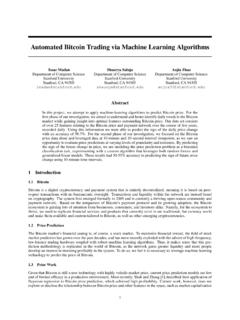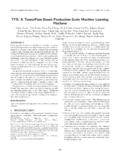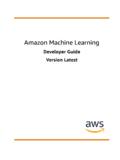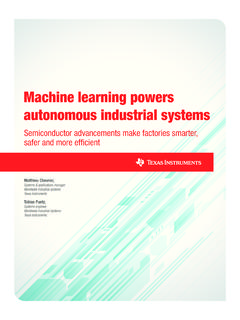Transcription of The Impact of Machine Learning on Economics
1 The Impact of Machine Learning on EconomicsSusan version January 2018 AbstractThis paper provides an assessment of the early contributions of Machine Learning to Economics , aswell as predictions about its future contributions. It begins by briefly overviewing some themesfrom the literature on Machine Learning , and then draws some contrasts with traditional approachesto estimating the Impact of counterfactual policies in Economics . Next, we review some of the initial off-the-shelf applications of Machine Learning to Economics , including applications in analyzingtext and images. We then describe new types of questions that have been posed surrounding theapplication of Machine Learning to policy problems, including prediction policy problems, as wellas considerations of fairness and manipulability. We present some highlights from the emergingeconometric literature combining Machine Learning and causal inference.
2 Finally, we overview aset of broader predictions about the future Impact of Machine Learning on Economics , including itsimpacts on the nature of collaboration, funding, research tools, and research IntroductionI believe that Machine Learning (ML) will have a dramatic Impact on the field of Economics withina short time frame. Indeed, the Impact of ML on Economics is already well underway, and so it isperhaps not too difficult to predict some of the paper begins by stating the definition of ML that I will use in this paper, describingits strengths and weaknesses, and contrasting ML with traditional econometrics tools for causalinference, which is a primary focus of the empirical Economics literature. Next, I review someapplications of ML in Economics where ML can be used off-the-shelf: the use case in economicsis essentially the same use case that the ML tools were designed an optimized for.
3 I then review prediction policy problems (Kleinberg et al., 2015), where prediction tools have been embedded inthe context of economic decision-making. Then, I provide an overview of the questions consideredand early themes of the the emerging literature in econometrics and statistics combining machinelearning and causal inference, a literature that is providing insights and theoretical results thatare novel from the perspective of both ML and statistics/econometrics. Finally, I step back anddescribe the implications of the field of Economics as a whole. Throughout, I make reference tothe literature broadly, but do not attempt to conduct a comprehensive survey or reference everyapplication in paper highlights several first theme is that ML does not add much to questions about identification, which concernwhen the object of interest, a causal effect, can be estimated with infinite data, but ratherI am grateful to David Blei, Guido Imbens, Denis Nekipelov, Francisco Ruiz, and Stefan Wager, with whom Ihave collaborated on many projects at the intersection of Machine Learning and econometrics and who have shapedmy thinking, as well as to Hal Varian, Mike Luca and Sendhil Mullainathan, who have also contributed to my thinkingthrough their writing, lecture notes.
4 And many great improvements when the goal is semi-parametric estimation or when there are a largenumber of covariates relative to the number of observations. ML has great strengths in using datato select functional forms second theme is that a key advantage of ML is that ML views empirical analysis as al-gorithms that estimate and compare many alternative models. This approach constrasts witheconomics, where (in principle, though rarely in reality) the researcher picks a model based onprinciples and estimates it once. Instead, ML algorithms build in tuning as part of the tuning is essentially model selection, and in an ML algorithm that is data-driven. There area whole host of advantages of this approach, including improved performance as well as enablingresearchers to be systematic and fully describe the process by which their model was selected.
5 Ofcourse, cross-validation has also been used historically in Economics , for example for selecting thebandwidth for a kernel regression, but it is viewed as a fundamental part of an algorithm in third, closely related theme is that outsourcing model selection to algorithm works verywell when the problem is simple for example, prediction and classification tasks, where perfor-mance of a model can be evaluated by looking at goodness of fit in a held-out test set. Thoseare typically not the problems of greatest interest for empirical researchers in Economics , who in-stead are concerned with causal inference, where there is typically not an unbiased estimate of theground truth available for comparison. Thus, more work is required to apply an algorithmic ap-proach to economic problems. The recent literature at the intersection of ML and causal inference,reviewed in this paper, has focused on providing the conceptual framework and specific proposalsfor algorithms that are tailored for causal fourth theme is that the algorithms also have to be modified to provide valid confidenceintervals for estimated effects when the data is used to select the model.
6 Many recent papers makeuse of techniques such as sample splitting, leave-one-out estimation, and other similar techniquesto provide confidence intervals that work both in theory and in practice. The upside is that usingML can provide the best of both worlds: the model selection is data driven, systematic, and a widerange of models are considered; yet, the model selection process is fully documented, and confidenceintervals take into account the entire , the combination of ML and newly available datasets will change Economics in fairlyfundamental ways, ranging from new questions, to new approaches to collaboration (larger teamsand interdisciplinary interaction), to a change in how involved economists are in the engineeringand implementation of What is Machine Learning and What are Early Use Cases?It is harder than one might think to come up with an operational definition of ML.
7 The term canbe (and has been) used broadly or narrowly; it can refer to a collections of subfields of computerscience, but also to a set of topics that are developed and used across computer science, engineering,statistics, and increasingly the social sciences. Indeed, one could devote an entire article to thedefinition of ML, or to the question of whether the thing called ML really needed a new nameother than statistics, the distinction between ML and AI, and so on. However, I will leave thisdebate to others, and focus on a narrow, practical definition that will make it easier to distinguishML from the most commonly used econometric approaches used in applied econometrics until readers coming from a Machine Learning background, it is also important to note1I will also focus on the most popular parts of ML; like many fields, it is possible to find researchers who definethemselves as members of the field of ML doing a variety of different things, including pushing the boundaries of MLwith tools from other disciplines.
8 In this article I will consider such work to be interdisciplinary rather than pure 2that applied statistics and econometrics have developed a body of insights on topics ranging fromcausal inference to efficiency that have not yet been incorporated in mainstream Machine Learning ,while other parts of Machine Learning have overlap with methods that have been used in appliedstatistics and social sciences for many from a relatively narrow definition of Machine Learning , Machine Learning is a fieldthat develops algorithms designed to be applied to datasets, with the main areas of focus beingprediction (regression), classification, and clustering or grouping tasks. These tasks are divided intotwo main branches, supervised and unsupervised ML. Unsupervised ML involves finding clusters ofobservations that are similar in terms of their covariates, and thus can be interpreted as dimension-ality reduction ; it is commonly used for video, images and text.
9 There are a variety of techniquesavailable for unsupervised Learning , including k-means clustering, topic modeling, community de-tection methods for networks, and many more. For example, the Latent Dirichlet Allocation model(Blei et al., 2003b) has frequently been applied to find topics in textual data. The output of atypical unsupervised ML model is a partition of the set of observations, where observations withineach element of the partition are similar according to some metric; or, a vector of probabilities orweights that describe a mixture of topics or groups that an observation might belong to. If youread in the newspaper that a computer scientist discovered cats on YouTube, that might meanthat they used an unsupervised ML method to partition a set of videos into groups, and when ahuman watches the the largest group, they observe that most of the videos in the largest groupcontain cats.
10 This is referred to as unsupervised because there were no labels on any of theimages in the input data; only after examining the items in each group does an observer determinethat the algorithm found cats or dogs. Not all dimensionality reduction methods involve creatingclusters; older methods such as principal components analysis can be used to reduce dimensionality,while modern methods include matrix factorization (finding two low-dimensional matrices whoseproduct well approximates a larger matrix), regularization on the norm of a matrix, hierarchicalPoisson factorization (in a Bayesian framework) (Gopalan et al., 2015), and neural my view, these tools are very useful as an intermediate step in empirical work in provide a data-driven way to find similar newspaper articles, restaurant reviews, etc., andthus create variables that can be used in economic analyses.
















![A arXiv:1409.0473v7 [cs.CL] 19 May 2016](/cache/preview/2/1/9/2/c/e/b/f/thumb-2192cebf55d1f97cb647eb48fdb384b3.jpg)
